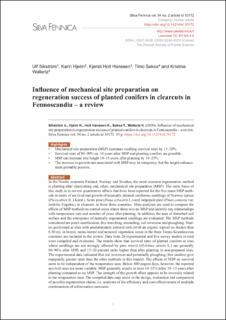| dc.description.abstract | In the Nordic countries Finland, Norway and Sweden, the most common regeneration method is planting after clearcutting and, often, mechanical site preparation (MSP). The main focus of this study is to review quantitative effects that have been reported for the five main MSP methods in terms of survival and growth of manually planted coniferous seedlings of Norway spruce (Picea abies (L.) Karst.), Scots pine (Pinus sylvestris L.) and lodgepole pine (Pinus contorta var. latifolia Engelm.) in clearcuts in these three countries. Meta analyses are used to compare the effects of MSP methods to control areas where there was no MSP and identify any relationships with temperature sum and number of years after planting. In addition, the area of disturbed soil surface and the emergence of naturally regenerated seedlings are evaluated. The MSP methods considered are patch scarification, disc trenching, mounding, soil inversion and ploughing. Studies performed at sites with predominately mineral soils (with an organic topsoil no thicker than 0.30 m), in boreal, nemo-boreal and nemoral vegetation zones in the three Fenno-Scandinavian countries are included in the review. Data from 26 experimental and five survey studies in total were compiled and evaluated. The results show that survival rates of planted conifers at sites where seedlings are not strongly affected by pine weevil (Hylobius abietis L.) are generally 80–90% after MSP, and 15–20 percent units higher than after planting in non-prepared sites. The experimental data indicated that soil inversion and potentially ploughing (few studies) give marginally greater rates than the other methods in this respect. The effects of MSP on survival seem to be independent of the temperature sum. Below 800 degree days, however, the reported survival rates are more variable. MSP generally results in trees 10–25% taller 10–15 years after planting compared to no MSP. The strength of the growth effect appears to be inversely related to the temperature sum. The compiled data may assist in the design, evaluation and comparison of possible regeneration chains, i.e. analyses of the efficiency and cost-effectiveness of multiple combinations of reforestation measures. | en_US |

